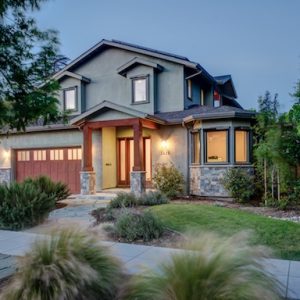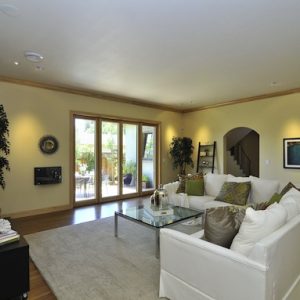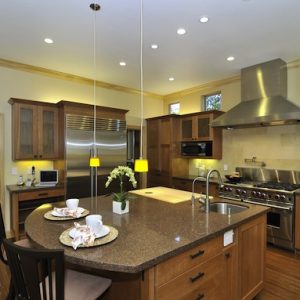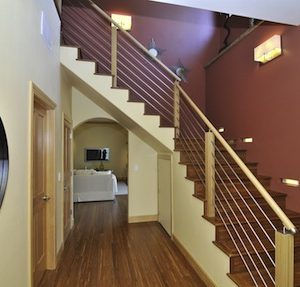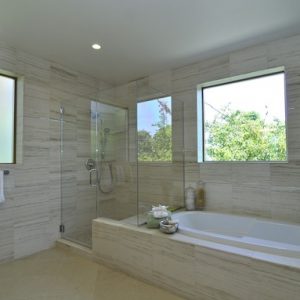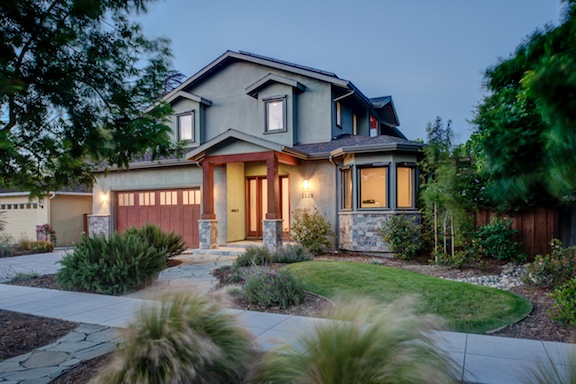In February of 2006 the California State Legislature passed a bill to require all new homes in the State to be built as ‘net zero energy’ by 2020. Scroll forward to 2008. Allen was looking for a challenge. He’d bought an old rancher in an established neighborhood of San Jose, just a few blocks away from where he had grown up. The old house itself was unremarkable, but the site was perfect for One Sky Homes to make its first foray into high performance territory. The target was set at Net Zero.
Primary Design Problems & Drivers:
· Nobody was doing this yet. The information available was mostly from books published back in the 70’s. Allen had copies of them all.
· Load calculations made a large south-facing roof area the biggest design requirement to accommodate the solar PV array.
· Allen wanted the house to look the same as any other suburban home and fit perfectly into this well established neighborhood.
Solutions:
Research on the Internet kept pointing to Passive House. Passive House California had recently been formed and a small group of other curious architects, designers and builders were all digging deep into the Passive House cookie jar. When Allen took the full Passive House training course in 2009, the house design was already permitted but most of the principles could still be implemented. Allen dug in and started using the PHPP to model his building.
Fun design features:
This house was designed and built as a luxury home. At the front door, old beams reclaimed from San Jose’s historic Del Monte fruit packing warehouse support the covered entry. The dings and scrapes of their original home are all still visible on their surface. They carry a century of San Jose history and now hold up the entry to another building that Allen hoped would add one more feather to the cap of his hometown.
The kitchen was designed as the heart of this home. It includes all premium appliances and carefully designed ‘cooking zones’ for a professional chef. A special cutout in the island allows veggie peelings to be dropped directly into a plexi-lined ‘compost’ drawer. The lining allows the drawer to easily be cleaned out at the end of the cooking session. A large, central island makes the kitchen the ‘stage’ of this home. It’s all about entertaining. Large, imported German doors in the living room open onto a large deck that steps down to a private, shaded back yard. It’s all about indoor-outdoor, California living.
Upstairs the home transforms into a secluded spa. The master bathroom includes a steam-room shower and spacious soaking tub, all trimmed out in travertine.
Outside this house boasts a grey-water collection tank that is used to irrigate the xeriscaped, indigenous plants and wild grasses. Solar-controlled exterior shades cover all the west-facing front façade windows. They keep this home perfectly cool and comfortable, even during the more frequent heat-storms this area has been experiencing over the past two years.
Mechanical systems:
The heating and cooling on this large, 2-story home with 9’-0” ceilings on both floors is handled by a Lennox XP21 heat pump. A Night Breeze, integrated with the heat pump, allows the building to dump any excess heat-build up during the day by drawing in the naturally cooler evening air that we enjoy here in our Mediterranean climate. A Zehnder ComfoAir 350 at 115 CFM provides mechanical ventilation. The large kitchen hood for the commercial 8-burner Wolf range is vented directly to the exterior, with a make-up air supply ducted directly to the toe-kick under the oven. Domestic hot water is provided by a solar thermal system with gas-powered AO Smith Vertex backup supply tank. An on-demand circulation pump allows minimal water waste by pre-heating the hot-water supply lines. The garage has a dedicated electric car charging station already installed. To provide the renewable, Net Zero Energy, the roof houses thirty 6.2kW PV panels for a total annual capacity of 11,100kWh of production.
Results:
We had a wall of certifications at the entry during our open house events. Most important of all was the HERS rating certificate that pegged this home at -1: the first new home to do so in the State of California. (The California Energy Commission issued a special declaration to recognize our achievement and we hosted a small ceremony at the home to celebrate this achievement.)
We squeaked in right under the 0.6ACH air-tightness requirement for Passive House and met all the other requirements to be certified as a PHIUS+ project. In addition to Passive House, this home is also a LEED Platinum, Indoor Air Plus and DOE Challenge Home.
More significantly, we’ve monitored the performance of this project over the past two years with the help of Davis Energy, the U.S. Department of Energy and Pacific Gas and Electric – our local utility. The measured results have been astonishingly close to what the PHPP predicted in our final energy model. The family of five that has been living in this home for the past two years has been able to supply all their energy needs – including their electric vehicle charging – by relying on the 30 panels mounted on the roof of their home. (This technically makes the home a PLUS Energy home.)
The Bottom Line:
We calculated the incremental costs to build this home to Passive House and Net Zero were $65,000 – a 7% increase from the basic amount we would have spent to build this home at code-minimum. We sold this house at barely above our cost to develop the full project, but the learning we earned by building it has brought us all our subsequent clients. We hope to be trading on this one at least until 2020, when everyone else in California finally drags themselves – kicking and screaming – over the ‘Net Zero’ Energy line.
